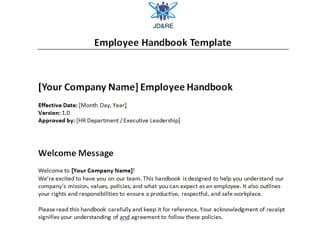
This post provides a professionally created employee handbook example that you can download, edit, and apply as a template in making one for your company or organization.
An employee handbook is one of the most essential documents in any organization. It serves as a comprehensive guide that outlines a company’s policies, culture, and expectations from employees.
Whether in a small business or a multinational corporation, a well-structured employee handbook promotes transparency, consistency, and mutual understanding between management and staff.
What is an Employee Handbook?
An employee handbook, sometimes called a staff manual or company policy guide, is an official document that communicates an organization’s rules, policies, procedures, and workplace standards to all employees.
It acts as both an orientation guide for new hires and a reference tool for existing staff, ensuring everyone understands what is expected of them and what they can expect from the company.
Key Features Commonly Contained in an Employee Handbook
While the content of employee handbooks may vary based on company size, industry, and state regulations, most handbooks include the following essential sections:
- Company Overview
This section introduces the company to employees. It often includes:
- The organization’s mission, vision, and values
- A brief history of the company
- The company’s goals, structure, and culture
The company overview section sets the tone for new employees and aligns them with the organization’s identity.
2. Employment Policies
This section of the employee handbook defines the fundamental employment principles, such as:
- Employment-at-will statement
- Equal employment opportunity (EEO) policy
- Americans with Disabilities Act (ADA) compliance
- Anti-discrimination and harassment policies
- Background check or verification requirements
These policies help ensure legal compliance and promote a safe, inclusive workplace.
3. Work Hours and Compensation
This section outlines how work schedules, pay, and attendance are managed:
- Standard work hours and shift schedules
- Attendance and punctuality expectations
- Overtime policies and pay structure
- Information on payroll frequency, deductions, and bonuses
Providing clarity on these topics reduces misunderstandings and payroll-related disputes between employees and employers.
4. Employee Benefits and Leave Policies
Employees should clearly understand their entitlements for working for the organization, including:
- Health, dental, and vision insurance
- Retirement plans (e.g., 401(k))
- Paid time off (PTO), vacation, and holiday schedules
- Family and Medical Leave Act (FMLA) policies
- Bereavement, jury duty, and military leave provisions
This section highlights the company’s commitment to employee welfare and work-life balance.
5. Workplace Conduct and Expectations
This section of the handbook provides the framework for acceptable behavior and ethics:
- Code of conduct and professionalism
- Dress code and appearance standards
- Use of company property and technology
- Social media and communication policies
- Drug- and alcohol-free workplace rules
A clear code of conduct fosters professionalism and accountability across all levels of the organization.
6. Safety and Security Policies
Safety is a priority in every workplace. This section covers:
- Workplace safety protocols and emergency procedures
- Reporting of accidents, injuries, or hazards
- Workplace violence prevention policies
By outlining safety expectations, the handbook reinforces the company’s duty of care to its employees.
7. Disciplinary and Termination Procedures
This part specifies how the company handles policy violations, including:
- Progressive disciplinary steps, including verbal warning, written warning, suspension, and termination
- Causes for immediate termination
- Resignation procedures and final paycheck details
Defining these processes ensures fairness, consistency, and protection from wrongful termination claims.
8. Acknowledgment of Receipt
Employees usually sign a form confirming that they have received and understood the handbook. This acknowledgment protects the employer legally and encourages accountability among employees.
Benefits of an Employee Handbook
The following are benefits to both the employee and employer for having an employee handbook:
- Promotes Transparency and Consistency
The handbook ensures that every employee receives the same information about workplace policies, minimizing confusion and favoritism.
- Serves as a Legal Safeguard
A well-drafted handbook helps employers demonstrate compliance with labor laws (e.g., EEO, FMLA, ADA) and provides evidence in disputes or lawsuits.
- Enhances Employee Onboarding
New employees can quickly understand company policies, benefits, and expectations, making it easier for them to integrate smoothly into the organization.
- Strengthens Workplace Culture
By sharing the organization’s mission, values, and code of ethics, the handbook reinforces a sense of belonging and cultural alignment among staff.
- Improves Communication
A central document for all workplace policies eliminates confusion, ensures clarity, and reduces HR’s administrative workload.
- Protects Employee Rights
Employees are informed of their rights, benefits, and channels for reporting grievances or harassment—promoting fairness and trust.
- Encourages Accountability
With clear rules and consequences, employees are more likely to act responsibly and uphold company standards.
Employee Handbook Example
Here is an example of an employee handbook that you can apply:
[Your Company Name] Employee Handbook
Effective Date: [Month Day, Year]
Version: 1.0
Approved by: [HR Department / Executive Leadership]
Welcome Message
Welcome to [Your Company Name]!
We’re excited to have you on our team. This handbook is designed to help you understand our company’s mission, values, policies, and what you can expect as an employee. It also outlines your rights and responsibilities to ensure a productive, respectful, and safe workplace.
Please read this handbook carefully and keep it for reference. Your acknowledgment of receipt signifies your understanding of and agreement to follow these policies.
1. Company Overview
1.1 Mission Statement
“To deliver exceptional [products/services] that enrich the lives of our customers and communities.”
1.2 Vision
“To be a trusted leader in [industry], known for innovation, quality, and integrity.”
1.3 Core Values
- Integrity and honesty
- Teamwork and collaboration
- Respect for all individuals
- Commitment to excellence
- Customer focus
- Accountability and continuous improvement
1.4 Company History
Provide a short background: when founded, major milestones, growth journey, and current operations.
2. Employment Basics
2.1 Employment-at-Will
All employment with [Company Name] is at-will, meaning either the employee or the company may terminate the employment relationship at any time, with or without cause or notice, unless otherwise specified by an employment contract or state law.
2.2 Equal Employment Opportunity (EEO)
We are an equal opportunity employer and prohibit discrimination based on race, color, religion, sex, sexual orientation, gender identity, national origin, age, disability, veteran status, or any other protected category under applicable law.
2.3 Americans with Disabilities Act (ADA)
We comply with the ADA and provide reasonable accommodations to qualified individuals with disabilities.
2.4 Immigration Law Compliance
We hire only individuals authorized to work in the United States and complete Form I-9 verification for all new employees.
2.5 Background Checks
Employment may be contingent upon successful completion of background checks or reference verification.
3. Work Hours, Attendance, and Scheduling
3.1 Work Hours
- Standard workweek: [e.g., Monday–Friday, 9 AM – 5 PM]
- Non-exempt employees: Eligible for overtime pay (1.5× after 40 hours/week).
- Exempt employees: Not eligible for overtime.
3.2 Attendance and Punctuality
Regular attendance is expected. Employees must notify their supervisor if they will be late or absent.
3.3 Breaks and Meal Periods
- Employees are entitled to [e.g., one 30-minute unpaid meal break and two 15-minute paid rest breaks per 8-hour shift] in accordance with state law.
4. Compensation and Performance
4.1 Payroll
- Paid [weekly/bi-weekly/monthly].
- Paydays: [specific day].
- Direct deposit is encouraged.
4.2 Overtime
Non-exempt employees are paid at 1.5× their regular rate for approved overtime hours exceeding 40 per week.
4.3 Performance Reviews
Conducted [annually/semi-annually] to evaluate job performance, provide feedback, and discuss career goals.
4.4 Promotions and Transfers
Opportunities are based on performance, skills, and company needs.
5. Benefits and Leave
5.1 Health and Insurance Benefits
Eligible employees may enroll in:
- Medical, dental, and vision insurance
- Life and disability insurance
- Retirement plan (e.g., 401(k))
5.2 Paid Time Off (PTO)
- PTO accrues at [rate, e.g., 10 days/year for full-time employees].
- PTO may be used for vacation, illness, or personal needs.
5.3 Holidays
Paid holidays include: [List federal or company-specific holidays].
5.4 Family and Medical Leave (FMLA)
Eligible employees may take up to 12 weeks of unpaid, job-protected leave for family or medical reasons as per federal law.
5.5 Other Leave Types
- Bereavement Leave – [e.g., 3 paid days]
- Jury Duty Leave – time off with proof of service
- Military Leave – in compliance with USERRA
6. Employee Conduct and Workplace Expectations
6.1 Code of Conduct
Employees are expected to act with professionalism, respect, and integrity in all dealings.
6.2 Anti-Harassment and Anti-Bullying
Harassment of any kind is prohibited. Complaints will be promptly investigated and resolved confidentially.
6.3 Drug-Free Workplace
Use, possession, or distribution of illegal drugs or alcohol during work hours is strictly prohibited.
6.4 Dress Code
Maintain professional attire suitable for your department or role.
6.5 Company Property and Technology Use
Company equipment and electronic resources are for business use only. Unauthorized access, downloads, or misuse of systems is prohibited.
6.6 Social Media Policy
Employees should avoid posting company-related content without approval and refrain from sharing confidential information.
7. Confidentiality and Data Protection
Employees must protect confidential and proprietary information, including client data, business strategies, and internal communications, even after leaving the company.
8. Safety and Security
8.1 Workplace Safety
Follow all safety procedures and report hazards or injuries immediately.
8.2 Emergency Procedures
In case of fire, natural disaster, or threat, follow the posted evacuation and safety plans.
8.3 Workplace Violence Prevention
Acts or threats of violence are strictly prohibited.
9. Disciplinary Policy
Depending on the situation, disciplinary action may include:
- Verbal warning
- Written warning
- Suspension
- Termination
The company reserves the right to skip steps based on the severity of the infraction.
10. Separation of Employment
10.1 Resignation
Employees are encouraged to provide at least [two weeks’] notice in writing.
10.2 Final Paycheck
Issued on the next scheduled payday or as required by state law.
10.3 Exit Interview
An exit interview may be conducted to gather feedback.
11. Acknowledgment of Receipt
I acknowledge that I have received and reviewed the [Company Name] Employee Handbook, understand its contents, and agree to comply with its policies.
Employee Name: ___________________________
Signature: _______________________________
Date: ___________________________
Appendices (Optional)
- Appendix A: State-specific employment laws (if applicable)
- Appendix B: Workplace safety manual
- Appendix C: Remote work policy
- Appendix D: Employee benefits summary
- Appendix E: IT and cybersecurity policy
Conclusion
An employee handbook is much more than a list of company rules, it’s a vital communication tool that shapes workplace culture, ensures legal compliance, and fosters mutual respect between employers and employees.
By maintaining an up-to-date, clearly written handbook, organizations can build a transparent, safe, and productive environment where both business goals and employee satisfaction thrive.
Free Employee Handbook Template
Download and edit the professionally created Employee Handbook.

